.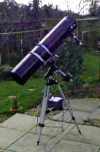
What I wanted was a scope capable of astrophotgraphy
and that could be moved when not in use. The
only option seemed to be to use a German
equatorial mount. To get away with a
cheaper mount the weight of the tube needed to
be kept as low as possible.
An aluminum tube was ordered 4" longer
than necessary, the extra length was removed
with tin snips and used to make the cradles

The cradles are lined with felt and the tension
required to hold the tube applied with a nut and
bolt.
Weight was again a major consideration when
making the mirror cell. The cut outs
both save a few grams and allow for quick
thermal equilibration of the mirror.
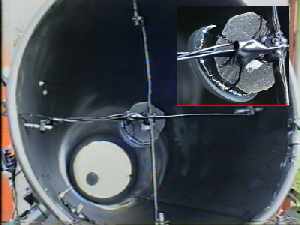
The spider is made if 2 strips of steel with
square nuts welded to each end. Bolts in
the tube allow some flexibility in positioning
of the mirror. A bolt welded to the middle
for the spider is threaded into a nut on the
secondary holder and provides the rotational and
vertical adjustment. The inset shows a
ring of 1/4W resistors which can provide a small
amount of heat to the secondary to prevent
condensation forming,
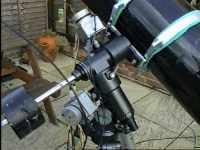
The Mount itself is a standard German
equatorial mount. I have added stepper
motors to each axis which are controlled by a PC
running Mel
Bartels telescope control software.
The polar axis scope makes aligning the mount
relatively painless. Although those living
further south would not have to bend over so
far.
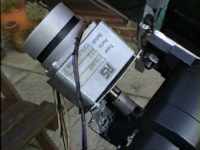 The 12V 200 step
steppers are connected to 25:2 gear boxes; this
gives a theoretical precision of 0.18 arc sec
per micro step. Though just as importantly
the gearboxes increases the toque available from
the motors. 2 Tips:- 1, When delivered the
mount had been put together with grease which
had the consistency of glue. When this was
replaced with a lighter grease the motors were
much less likely to stall. 2, Using
proper flexible motor linkages to connect to the
slow-motion controls instead of car fuel piping
much reduced the backlash in the system. The 12V 200 step
steppers are connected to 25:2 gear boxes; this
gives a theoretical precision of 0.18 arc sec
per micro step. Though just as importantly
the gearboxes increases the toque available from
the motors. 2 Tips:- 1, When delivered the
mount had been put together with grease which
had the consistency of glue. When this was
replaced with a lighter grease the motors were
much less likely to stall. 2, Using
proper flexible motor linkages to connect to the
slow-motion controls instead of car fuel piping
much reduced the backlash in the system.
The electrical components required to run the
motors is contained in a box with a large
ammeter on the front. It is useful to know
the current drawn by the motors when adjusting
the software parameters. Also a hand
controller is required in order to slew and
guide the scope. The super Nintendo
controller could of been made for the purpose.
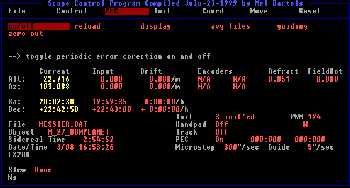
The software has no end of nice features
including PEC, automatic drift computing
and interfacing with planetarium software.
Also it isn't fussy about the spec of machine
its running on ( a second hand 386 in this
case).
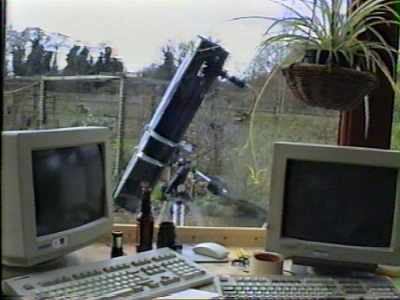
The big
advantage with this system is being able to
enjoy a all night observing session in the warm
as the water in the garden pond freezes to a
depth of 2". The computer on the
right controls the telescope while the left hand
one has the planetarium software and controls
the ccd camera.


|